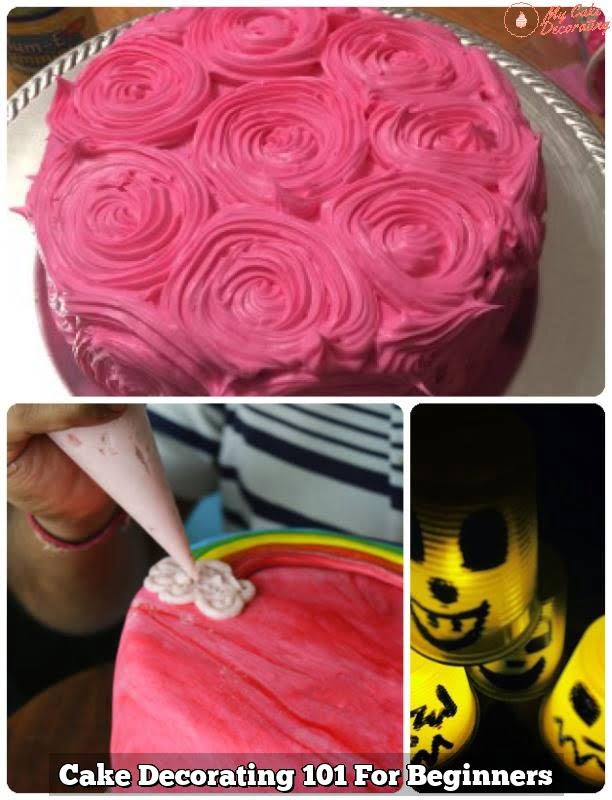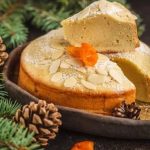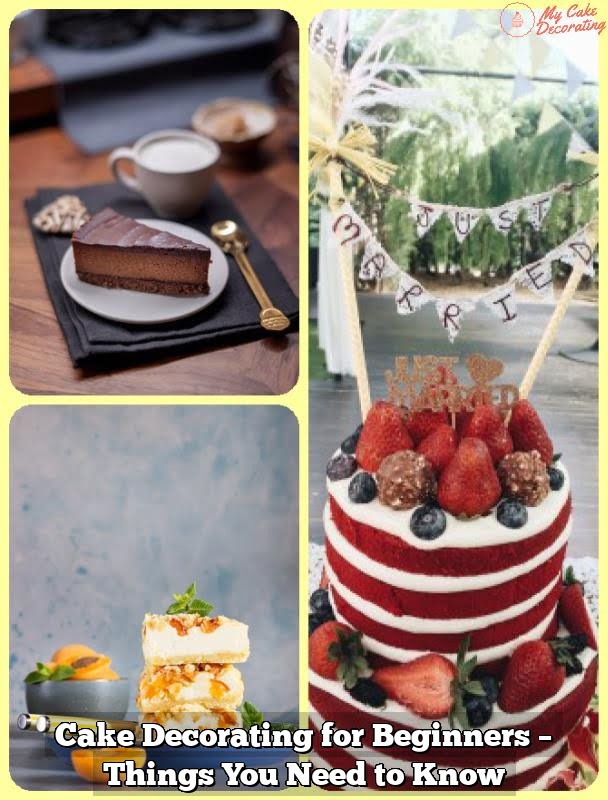Cake decorating is a delightful and creative activity that allows beginners to transform plain cakes into stunning works of edible art. Whether you have no prior experience or are looking to enhance your baking skills, cake decorating offers a world of possibilities for expressing your creativity and adding a touch of magic to any occasion.
In this article, we will delve into the beauty and fun of cake decorating for beginners, exploring everything from essential tools and techniques to beginner-friendly ideas and themes.
Decorating a cake is like painting on a canvas – it gives you the opportunity to let your imagination run wild and create something truly unique. From elegantly piped borders to intricately designed fondant sculptures, cake decoration allows you to elevate a simple baked good into an eye-catching centerpiece that will captivate both young and old.
It’s not only about aesthetics, but also about the joy that comes with creating something from scratch and seeing the smiles on people’s faces when they indulge in your edible masterpiece.
Before diving into the world of cake decorating, it’s important to understand the essential tools needed for success. In the following sections, we’ll provide a comprehensive guide on cake decorating supplies – from piping bags and tips to fondant cutters and molds – ensuring that you have all necessary equipment in your toolkit.
We’ll also discuss the importance of choosing the right cake base as your canvas, as different types of cakes lend themselves better to specific decorating techniques and themes.
So whether you dream of crafting intricate sugar flowers or simply want to master the art of buttercream icing, this article will serve as your go-to resource for all things cake decorating. Get ready to embark on a journey filled with creativity, artistry, and above all else, deliciously beautiful cakes that are sure to impress friends, family, and even yourself.
The Essential Tools
Cake decorating is a fun and creative hobby that allows beginners to express their artistic skills while also creating delicious treats. However, in order to create stunning cake designs, it is important to have the essential tools and supplies. This comprehensive guide will provide beginners with an overview of the must-have cake decorating supplies.
One of the most basic tools that every cake decorator needs is a set of icing bags. These bags are used to hold and dispense icing onto the cake, allowing for precise and detailed designs. It is recommended to have a variety of sizes to accommodate different decorating needs.
Additionally, icing tips or nozzles are necessary for creating different shapes and textures such as stars, flowers, or ruffles. Beginners should start with a basic set of tips and gradually expand their collection as they gain more experience.
Another essential tool is an offset spatula. This tool is used for spreading and smoothing icing onto the cake’s surface. Its angled shape helps decorators reach all areas of the cake easily and achieve a professional-looking finish. A turntable is also highly recommended, as it allows decorators to rotate the cake while working on it, ensuring even distribution of icing and better control when applying decorations.
In addition to these basic tools, other supplies that beginners should consider investing in include:
- Cake Leveler: Used for evening out the tops of cakes and achieving uniform layers.
- Piping Bags: Reusable bags for piping intricate designs or writing on cakes.
- Fondant Smoothers: Essential for achieving a smooth surface when working with fondant.
- Edible Glitter or Sprinkles: Adds an extra touch of sparkle and fun to any design.
- Food Coloring: Helps create vibrant shades for icings or fondants.
By having these essential tools in their arsenal, beginner cake decorators can get started on their creative journey with confidence. With practice and experimentation, they will be able to create beautiful cakes that are a feast for both the eyes and the taste buds.
The Perfect Canvas
When it comes to cake decorating, choosing the right cake base is essential. The cake base serves as the foundation for your masterpiece and can greatly affect the overall presentation and taste of your creation. Here are some tips to help you choose the perfect canvas for your cake decorating:
- Size and Shape: Consider the size and shape of your cake when choosing a base. If you’re making a tiered or layered cake, make sure each layer is stacked on a sturdy base that can support the weight. Round, square, and rectangular bases are common options, but don’t be afraid to get creative with unique shapes like hearts or stars.
- Flavor: Think about what flavor would complement your cake design. Vanilla or chocolate bases are versatile options that pair well with most flavors of cakes and icings. If you’re feeling adventurous, consider using flavored bases like lemon or red velvet to add an extra touch of excitement to your creation.
- Texture: The texture of the cake base can also add visual appeal to your design. A smooth fondant-covered base provides a sleek and polished look, while a crumb-coated buttercream base conveys a more rustic feel. Consider how different textures can enhance the overall aesthetic of your finished cake.
- Special Dietary Needs: If you or someone you’re baking for has dietary restrictions or preferences, be sure to choose a cake base that accommodates those needs. Gluten-free, dairy-free, and vegan options are widely available so that everyone can enjoy your beautifully decorated cakes.
Remember, choosing the right cake base is just as important as the decorating itself. Your choice will impact not only how visually stunning your creation is but also how enjoyable it is to eat. So take your time when selecting the perfect canvas for your masterpiece – it’s worth putting in that extra effort.
The Art of Icing
Icing is a crucial element in cake decoration as it provides the smooth and glossy finish that makes a cake look professional and appealing. There are various types of icings that can be used to achieve different effects, and each has its own unique qualities and techniques. In this section, we will explore the different types of icings and techniques that can be used to create beautiful cake decorations.
One of the most popular types of icing is buttercream icing, which is made from butter or shortening, powdered sugar, liquid (such as milk or water), and flavorings. Buttercream icing is versatile and easy to work with, making it ideal for beginners. It can be colored, piped into shapes, and used to create various textures such as rosettes, ruffles, or borders. Another advantage of buttercream icing is its delicious taste.
Fondant icing is another commonly used type of icing in cake decorating. Fondant is a pliable sugar paste that can be rolled out and draped over a cake to give it a smooth and flawless appearance. It can also be molded into shapes, cut into designs, or used for intricate details. While fondant provides a clean finish, it may not have the same soft texture as buttercream icing.
Royal icing is popular for creating intricate designs on cakes as it hardens when dry. It is made from powdered sugar, egg whites or meringue powder, and water. Royal icing can be piped onto a cake using different nozzles to create lace-like patterns, flowers, or other decorative elements. It can also be used to stick decorations onto a cake or hold different layers together.
In addition to these traditional icings, there are also ganache (a combination of chocolate and cream) which provides a rich and shiny finish; whipped cream which gives a light and airy texture; and cream cheese icing which adds tanginess to cakes.
Overall, choosing the right type of icing depends on the desired effect, taste preferences, and level of difficulty. Each type comes with its own set of techniques and tools, so it’s important to practice and experiment to find the ones that work best for your cake decorating projects.
| Type of Icing | Key Features | Techniques |
|---|---|---|
| Buttercream icing | Versatile, easy to work with, delicious taste | Coloring, piping shapes and textures |
| Fondant icing | Gives a smooth and flawless appearance | Rolling out, draping over cakes, molding into shapes or designs |
| Royal icing | Hardens when dry, ideal for intricate designs | Piping lace-like patterns, flowers or decorative elements |
From Simple to Stunning
Cake decorating is not just about creating a beautiful and delicious dessert; it is also an opportunity for self-expression and creativity. As a beginner, it can be overwhelming to come up with ideas for cake decorations that are both impressive and achievable. Luckily, there are plenty of beginner-friendly cake decorating ideas and themes to inspire you and help you create stunning cakes.
One popular theme for beginners is the floral theme. Flowers can be made using various techniques such as piping buttercream, molding fondant or gum paste, or even using fresh flowers as decorations. Floral cakes can range from simple designs with a few piped flowers to more elaborate creations featuring cascading flowers or entire bouquets.
Another idea that is perfect for beginners is the ombre effect. This technique involves blending different shades of the same color on the cake to create a gradient effect. It can be achieved using buttercream icing or even fondant. Ombre cakes can be simple but visually striking, making them perfect for any occasion.
For those who prefer a more whimsical touch, animal-themed cakes are a great option. You can choose to recreate your favorite animal entirely on the cake or use animal-themed decorations like figurines or cut-outs. Animal-themed cakes are not only adorable but also allow for endless creativity in terms of colors, patterns, and textures.
When it comes to choosing cake decorating ideas and themes as a beginner, it’s important to start with something that sparks your interest and matches your skill level. As you gain more experience and confidence in your skills, you can move on to more intricate designs and techniques.
| Cake Decorating Ideas | Description |
|---|---|
| Floral Theme | Create stunning flower arrangements using buttercream or fondant. |
| Ombre Effect | Blend different shades of the same color on the cake to create a gradient effect. |
| Animal-themed Cakes | Recreate your favorite animals or use animal-themed decorations for a whimsical touch. |
Step-by-Step
Whether you’re a beginner or have some experience in cake decorating, having a strong foundation in basic techniques is crucial. These techniques provide the building blocks for creating beautiful and professional-looking cakes. In this section, we will explore some of the essential step-by-step cake decorating techniques that every beginner should know.
One fundamental technique is leveling and torting the cake. Leveling ensures that your cake has an even surface, while torting involves cutting the cake into multiple layers. To level a cake, start by placing it on a flat surface and carefully slice off any excess using a long serrated knife.
Torting requires cutting the leveled cake horizontally using either a serrated knife or a cake leveler. This technique allows you to add different fillings between the layers, adding depth and flavor to your creation.
Another basic technique is crumb coating or applying a thin layer of icing to seal in any loose crumbs before decorating. Begin by spreading a thin layer of icing over the entire cake using an offset spatula or bench scraper. Once done, refrigerate the cake for about 15 minutes to allow the crumb coat to set before moving on to the final layer of icing.
Creating smooth and even icing on your cake is another important technique. Start by applying a generous amount of icing on top of the chilled crumb coat, then use an offset spatula to spread it evenly across the surface. To achieve that smooth finish, hold the spatula at an angle against the side of the cake and rotate it slowly while removing excess icing with each rotation.
These are just a few basic techniques that will help beginners get started in their cake decorating journey. Remember, practice makes perfect, so don’t be discouraged if your first attempts aren’t flawless. With time and patience, you’ll develop your skills and be able to create stunning cakes that will impress everyone around you.
Common Mistakes to Avoid
Uneven Icing
One of the most common mistakes that beginners make when decorating cakes is applying icing unevenly. This can result in a lumpy and unprofessional-looking finish. To avoid this, it is important to have a smooth and even layer of icing on your cake.
Start by crumb coating your cake, which means applying a thin layer of icing to seal in any loose crumbs. Once this layer has set, you can then apply a thicker layer of icing for the final decoration.
To ensure an even application of icing, use an offset spatula or a bench scraper to spread the icing smoothly on the cake. Begin at the top and work your way down the sides, rotating the cake as you go. Make sure to apply consistent pressure and check for any uneven spots as you frost. If you do encounter any bumps or ridges, gently smooth them out with your spatula or scraper.
Color Mishaps
Another common mistake that beginners make is not achieving the desired color for their cake decorations. Whether it’s frosting that turns out too pale or fondant that ends up too dark, color mishaps can be disappointing. To avoid this, it is crucial to start with a small amount of coloring and gradually add more until you achieve the desired shade.
When working with gel or liquid food coloring, remember that colors tend to deepen over time, so it’s better to start with less than what you think you need. If you want a more intense color, consider using concentrated gel food coloring instead of liquid drops. Be sure to mix colors thoroughly so that there are no streaks or clumps in your frosting or fondant.
If you do end up with a color mishap, don’t panic. There are ways to fix it. For frosting, you can try adding more powdered sugar to lighten it or using cocoa powder to darken it. For fondant, knead in small amounts of white or colored fondant to achieve the desired shade. Remember, practice makes perfect, and experimenting with colors can lead to surprising and beautiful results.
Smudged Designs
Creating intricate and detailed designs on cakes can be a daunting task for beginners, but with practice and patience, anyone can achieve stunning results. However, one common mistake that often occurs is smudging or smearing the design while working on it. This can happen when the icing or decorations aren’t set properly, making it vulnerable to accidental contact or movement.
To avoid smudging your designs, make sure that the base layer of icing is completely dry before adding any decorations or piping details. If necessary, refrigerate the cake for a short time to help set the icing faster. When piping intricate designs, start from the outer edges and work your way inward to avoid accidentally touching previously piped areas. Additionally, avoid placing your hands directly on the cake when applying delicate decorations or transferring it onto a serving plate.
If you do encounter a smudge or smear in your design, don’t fret. Depending on the severity of the mistake, you may be able to gently remove some of the decoration without damaging the cake underneath. Alternatively, you can cover up minor mistakes by strategically adding extra details or using edible glitter or sprinkles to distract from them.
By being aware of these common mistakes and knowing how to troubleshoot them, beginners can enhance their cake decorating skills and create flawless designs that are sure to impress. Remember that perfection takes practice, so don’t be discouraged if things don’t go perfectly at first. With time and experience, you’ll become more confident in your abilities and be able to overcome any decorating challenges that come your way.
Taking It to the Next Level
After mastering the basic techniques of cake decorating, many beginners are eager to take their skills to the next level and tackle more advanced projects. Thankfully, there are plenty of tips and tricks that can help you further refine your cake decorating abilities and create truly impressive designs.
One important aspect of advancing your cake decorating skills is experimenting with new tools and techniques. As a beginner, you may have started with basic piping tips and spatulas, but now is the time to explore more specialized tools such as fondant smoothers, stencils, and airbrushes. These tools can help you achieve more intricate designs and add professional-looking finishes to your cakes.
Additionally, learning new decorating techniques can greatly enhance your skill set. For example, practicing different types of flower or figure piping can allow you to create more realistic and detailed designs. Brush embroidery is another technique worth exploring, as it adds texture and dimension to your cake decorations. Taking a decorating class or watching online tutorials can provide valuable guidance on these intermediate techniques.
As you advance in your cake decorating journey, don’t be afraid to step out of your comfort zone and try new things. Push yourself to experiment with bold color combinations or unconventional design elements. You never know what interesting creations may come from your willingness to take risks.
By continuously challenging yourself, exploring new tools and techniques, and embracing creativity in your cake decorating projects, you will undoubtedly see significant growth in your skills. Remember that practice makes perfect – so keep learning, experimenting, and enjoying the process. With dedication and perseverance, you will soon be creating stunning masterpieces that amaze both yourself and others.
Masterpiece in Progress
One of the most inspiring aspects of cake decorating is seeing the incredible creations that others have made. Whether it’s a beautifully detailed wedding cake or a whimsical birthday creation, real-life cake decorating inspiration can fuel your creativity and motivate you to try new techniques. In this section, we will showcase some amazing cake decorating projects and share success stories from beginners who have turned their passion for cake decoration into something truly remarkable.
Celebrating Personal Milestones
Some of the most memorable cake decorating projects are those that celebrate special milestones in people’s lives. From baby showers to graduations to anniversaries, there are countless opportunities to create unique and meaningful cakes. For example, imagine a cake decorated with delicate sugar flowers and elegant piping to celebrate a couple’s 50th wedding anniversary.
Or picture a whimsical baby shower cake featuring adorable fondant animals and pastel colored icing. These types of cakes not only showcase the technical skills of the decorator but also bring joy and happiness to those celebrating important moments in life.
Community Building and Competition
Cake decorating can also be a way to connect with others who share your passion. Many cities have cake decorating communities where enthusiasts gather to share ideas, techniques, and even compete in friendly competitions. These events provide valuable opportunities for beginners to learn from more experienced decorators, gain feedback on their work, and get inspired by the talent around them.
For example, one success story comes from Sarah Morgan, a beginner decorator who entered her first cake competition at her local community fair. Despite being nervous about competing against more seasoned decorators, she took home first place for her elegant wedding cake design. This experience not only boosted her confidence but also introduced her to fellow decorators who later became lifelong friends and mentors.
The Power of Social Media
In today’s digital age, social media platforms like Instagram and Pinterest have become powerful tools for sharing and discovering cake decorating inspiration. Many decorators, both beginners, and professionals alike, showcase their work online and engage with a vibrant community of cake enthusiasts. By following popular hashtags or joining online groups, beginners can stay updated with the latest trends, learn new techniques, and even connect with potential clients.
One success story that highlights the power of social media is from Adam Jackson, a self-taught cake decorator who gained a massive following on Instagram. His unique style of abstract cake designs caught the attention of influencers in the culinary world, leading to collaborations with renowned chefs and opportunities to display his work at high-profile events.
Through the exposure he gained on social media platforms, Adam was able to turn his passion for cake decorating into a thriving business.
Conclusion
Cake decorating is a truly captivating and rewarding art form that has endless possibilities for beginners and beyond. Throughout this article, we have explored the essential tools, cake bases, icing techniques, decoration ideas, and troubleshooting tips that will help beginners create stunning cakes. We have also discussed intermediate tips and tricks to take your cake decorating skills to the next level.
One of the most exciting aspects of cake decorating is the sheer creativity it allows. Whether you are a beginner experimenting with basic techniques or an experienced decorator pushing the boundaries of design, there are always new ideas and themes waiting to be explored. From elegant wedding cakes to whimsical birthday creations, cake decorating offers a blank canvas for your imagination.
Furthermore, cake decorating can provide a platform for personal expression and celebration. The joy and satisfaction that comes from creating a beautiful cake, watching it come to life step by step, is incomparable. The pride in presenting your masterpiece at special occasions is truly priceless.
Finally, as you continue your journey in cake decorating beyond the beginner stage, remember to keep learning and growing. Seek inspiration from other decorators’ success stories showcased in magazines or online communities. Experiment with new techniques; challenge yourself with more complex designs. With dedication and practice, you can turn your passion for cake decorating into something extraordinary.
So go ahead and unleash your creativity. Explore the limitless possibilities of cake decorating and let your imagination soar. Whether you are just starting out or taking it to new heights as an intermediate decorator, remember that every cake you create is an opportunity for artistry and celebration. Enjoy every moment of this sweet adventure.

Welcome to my blog about home and family. This blog is a place where I will share my thoughts, ideas, and experiences related to these important topics. I am a stay-at-home mom with two young children. I hope you enjoy reading it! and may find some helpful tips and ideas that will make your home and family life even better!





